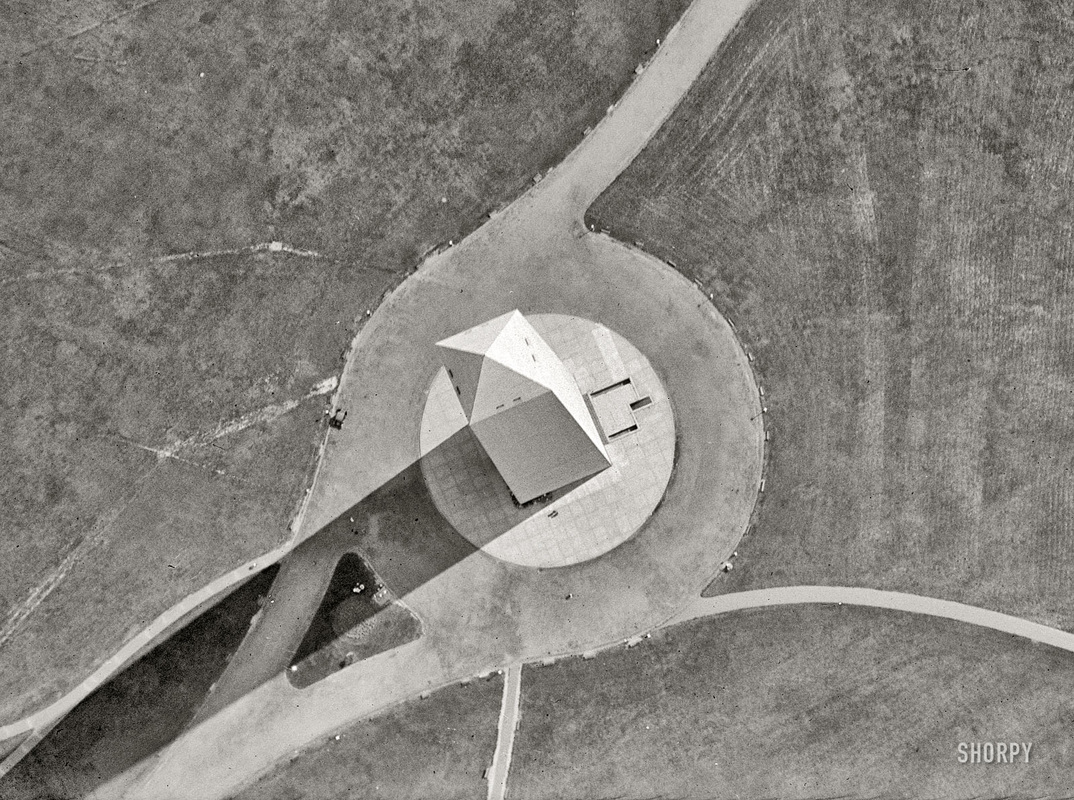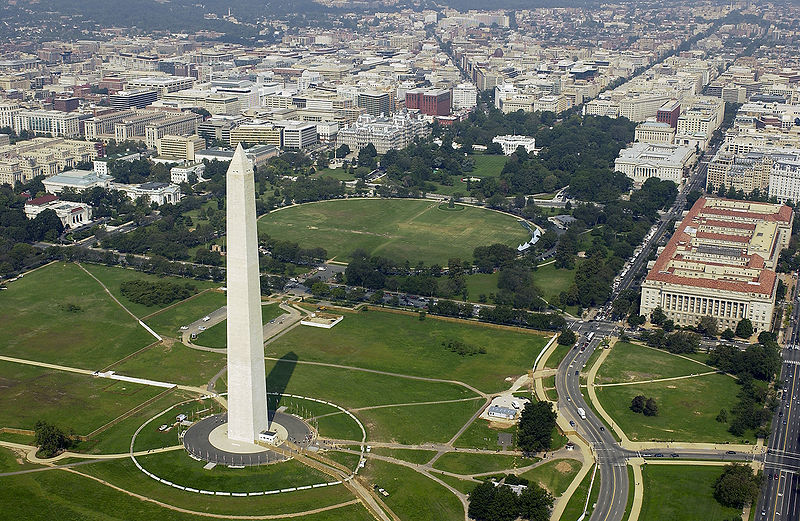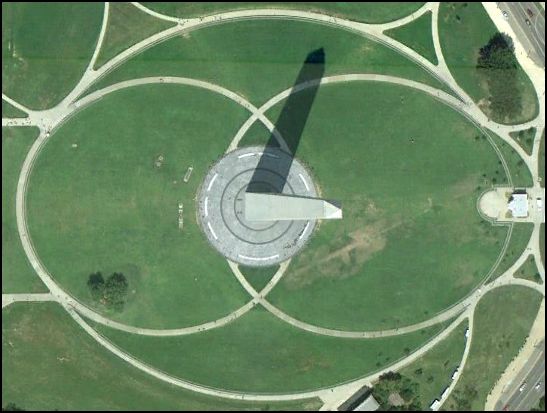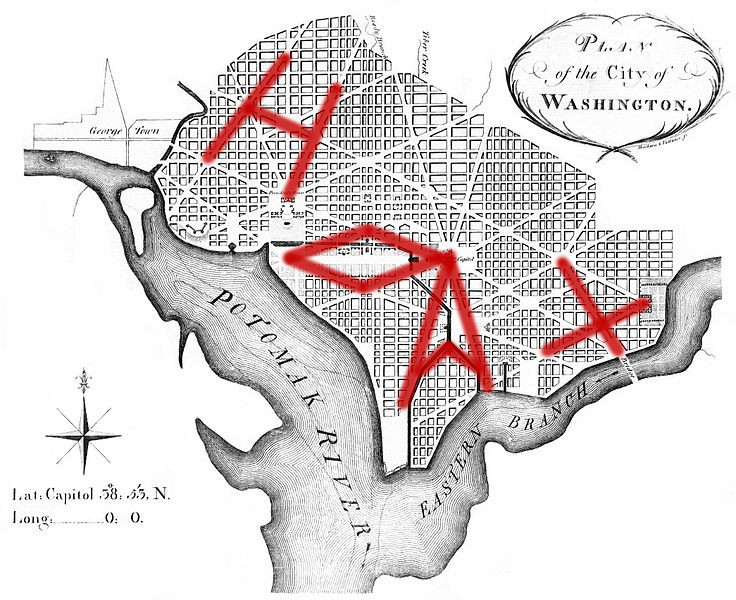|
I am frankly at something of a loss to determine how best to introduce tonight’s episode of America Unearthed. It immediately recalls the Dan Brown novel The Lost Symbol (2009), which also featured Freemasons, hidden symbolism in Washington, DC, and the suggestion of suppressed religious truths. Normally, I have a list of historical background material that places the episode’s claims in context, but this is somewhat hard to do in this case since the claims on offer tonight emerge largely from the historical fantasia concocted by Alan Butler and his longtime writing partner, Christopher Knight, and not all that long ago. The fullest account is Butler’s own, in City of the Goddess: Freemasons, the Sacred Feminine, and the Secret beneath the Seat of Power in Washington, DC (Watkins, 1999). Oh, and both of tonight’s protagonists—Alan Butler and Scott Wolter—have, directly or indirectly, threatened me with legal action.* * I have amended the wording from "tried to sue me" in order to be absolutely, painfully accurate after Steve St. Clair demanded legally unimpeachable wording. Background Regular readers are well aware that, according to the attorney involved, Scott Wolter asked A+E Networks to threaten suit against me earlier this year in an effort to quash publication of a printed collection of my America Unearthed reviews. But for this episode I also need to disclose before discussing Alan Butler that he and Christopher Knight sent me a threat of legal action because they mistakenly believed it was illegal for me to review their 2004 book Civilization One prior to its publication date without their permission, despite the fact that their own publisher had sent me advanced galley proofs and asked for an early review in Skeptic magazine. Because there was no embargo on the book’s contents (nor would I have signed such an agreement), there was nothing illegal about reviewing the book. The authors' publicist eventually apologized to me. This disclosure is particularly important because that 2004 book introduced Butler’s ideas about the “megalithic yard,” abbreviated by him as the MY, which Butler also wants to apply to the layout and design of Washington, DC. We’ll get to that in just a moment, but first a little bit of background on the pseudoscientific uses of metrology is probably in order. For a long, long time nobody really cared all that much about units of measurement. Most measurements were based on the human body, and as such they varied significantly from location to location depending on who was doing the measuring. Even when a relatively standardized set of measurements came into force in a given time or place, they were not shared across cultures or from one time period to the next. Thus, the Romans and the Egyptians, for example, did not share their units of measurement. For the most part, this ad hoc system of local measurements continued down to the early modern period, when the rise of science led to a movement for more consistent units of measurement. Queen Elizabeth I standardized the mile, for example. In the late sixteenth century the forerunner of the metric system was first proposed, and it was fully developed during the 1600s. In these same years, John Greaves, an Oxford don, launched modern pyramidology by publishing a tract called Pyramidographia (1646) discussing the measurements of the Great Pyramid. It was the age of scientific metrology. Then, during the French Revolution, France adopted the metric system, which at the time was based on estimates of the earth’s polar circumference. Long story short, fringe theorists took inspiration and started to wonder if ancient people hadn’t based their measurements on the size and shape of the earth as well. In 1859 John Taylor claimed that Noah had built the Great Pyramid as a scale model of the earth. This culminated in astronomer Charles Piazzi Smyth’s Our Inheritance in the Great Pyramid (1864), in which he not only agreed but also determined that the measurements used, the so-called pyramid inch, were inspired by God and could predict the future. The idea of a prehistoric, quasi-divine unit of measurement took hold from here, given a boost by early twentieth century speculation (later refuted) that ancient cultures like Egypt and Mesopotamia shared a single prehistoric unit of measurement. The Italian historian Livio Stecchini, a defender of Velikovsky, assumed all measurements were related and proceeded to “prove” it by concluding that all measurements derive from an exceedingly accurate Egyptian knowledge of the earth’s circumference. His system was so complex that it involved four different feet, in a ratio of 15:16:17:18, with each foot having two variants based on the cube root of 24 and the cube root of 25. He never provided hard evidence that any of these measurements were actually used in archaeological sites, but his work inspired claims in numerous New Age and fringe books, not least of which was Hamlet’s Mill. This was the same time that the Megalithic Yard sprang into existence, emerging from the same milieu of speculation about precision measurements and ancient wisdom, a reflection of the Cold War emphasis on scientific advancement projected back into an imaginary past. The MY is an imaginary measurement developed by Alexander Thom based on incorrect mathematical computations of the measurements of megalithic European sites. Even though megalithic sites are made from irregular blocks and many sites are heavily damaged, Thom concluded that the original measurements used by more than 100 megalithic sites favored a basic unit of measurement of 2.72 feet, give or take a smidge, and this implied a central prehistoric bureau of weights and measures. Critics noted that Thom’s measurements based on damaged sites and were, in places, off by as much as a foot, drastically affecting his statistical analysis used to compute his yard. Today, most archaeologists believe that there was some effort at standardized units, likely based on the human body, but that they were not applied as rigorously or as accurately as Thom believed. In short, he discovered that people tended to use their feet to measure things at a time when most of their feet were a bit smaller than ours. Nevertheless, because Thom was working in the age of the counterculture and Gerald Hawkins’s claims about Stonehenge as a “prehistoric computer,” New Agers adopted his ideas as proof of a lost civilization, perhaps even Atlantis, that pre-planned prehistory. Knight and Butler decided that the MY could be determined to the ten-thousandth of a millimeter, giving that measurement as 82.96656 cm, based on a conversion of a slight variant of the MY’s imperial measurement into metric, without consideration for the fact that a converted measurement cannot be more accurate than the original unit of measurement. (They generally round it to 82.3 in Civilization One.) They also decided that the MY wasn’t just a unit derived from the human body. Instead, adopting Stecchini’s ideas (influenced in turn by Piazzi Smyth’s), they proposed that the MY was a fractional measurement of the earth’s circumference as calculated from an assumed prehistoric 366-degree circle. Butler provided no archaeological evidence of a 366-degree circle but claims to have derived the number from the Phaistos Disk because that possibly Minoan artifact contained 30 divisions on the obverse and 31 on the reverse, suggesting 366-day calendar on a cycle of 40 years (with a 40-day intercalary month). For Butler, a Minoan 366-day calendar implied a 366-degree division of the cosmos, especially since the 40-year cycle echoed Thom’s suggestion that 40 megalithic inches made up the MY. I trust it is obvious to you that that there is absolutely no reason to suggest any connections between these numbers. Indeed, our 360-degree circle is no corruption of an older 366-degree circle; the convention of assigning 360 degrees to circle derives from Babylon’s use of a base-60 system. There is no evidence for any 366-degree system or circle. The coincidences Butler sees in support of it derive from the fact that 360 and 366 are both divisible by 2, 3, and 6, and produce fractional values that can be computed with 4, 9, and 12. Butler claims that in a 366-degree earth where each degree contains 60 minutes made up of 6 arc seconds each, that each arc second is exactly 366 MY wide. Let’s crunch the numbers using Thom’s 2.72 feet: 366 X 60 X 6 X 366 X 2.72 divided by 5,280 gives us 24,843 miles, about 60 miles too small for the earth’s equatorial circumference. Let’s try a different way: The earth’s circumference is 24,901 miles at the equator. So, dividing it out, we get 2.726 feet to the “yard,” which, to two significant figures, gives us 2.73. It’s close, but no cigar. Using the metric figures yields a calculation of 83.10 cm to the “yard,” which does not agree with Butler’s own 82.97. Running the numbers the other way from Butler’s figures out gives us 40,010 km, which does not match the 40,090 km of the earth’s circumference. Using the polar circumference gives us a better fit, since the 40,010 km more closely matches the polar circumference of 40,007 km. Running the numbers the other way, it gives us a megalithic yard of 82.960 cm. In imperial units, 24,860 miles gives us a “yard” of 2.722 feet, and Thom’s 2.72-foot MY yields a circumference of 24,843 miles. It’s cute, but it depends entirely on asserting a sixty degree arc minute and six arc seconds, a fudge factor for which there is no archaeological support. Working backward, we can see that to achieve his results, Butler simply divided the polar circumference (and why polar except that’s what the metric creators did?) by the length of the MY and then by 366 twice. He then rationalized the inconvenient remainder of 360. But many different numbers could be rationalized as some combination of the key numbers of 2, 3, 6, 9, and 12 since there are so many possibilities. It’s a neat coincidence that this works out to 60 and 6, but 366 divided by 6 yields 61, not 60, which should be the more logical number of minutes to aim for. Butler and Knight use these same numbers to propose whole sets of relationships related to mass, weight, volume, and even temperature—they say that if absolute zero is negative 1000 degrees, then water boils at 366 degrees. “Remarkable!” they proclaimed in Before the Pyramids (2009), oblivious apparently to the fact that temperature scales are arbitrary and the size of a degree differs between Fahrenheit and Celsius and can’t be said to be inherent in the universe. Butler has previously attached the Megalithic Yard to Washington, DC in Before the Pyramids and on the Washington DC’s Chamber of Secrets website—which despite its name is not an American remake of Harry Potter. Instead, it’s a crackpot assemblage of bizarre claims about Washington, including (and I am not making this up) the “fact” that the Ark of the Covenant is buried in front of the White House and the “fact” that Washington, DC and Teotihuacan in Mexico share a mathematical relationship to the moon (which he believes was built by time traveling Freemasons from the future, or at least people who shared the same cult beliefs) as well as the asteroid Ceres (which he also believes is artificial): The makers of the Moon created Ceres and left it in the Asteroid Belt to show that they had taken most of the material for Earth's Moon from the Asteroid Belt. They gave Ceres a quite remarkable relationship with the Moon in terms of its size and mass and they also replicated its circumference on Earth, between Washington DC (which is the most Megalithic city ever created) and another Megalithic city from the past, Teotihuacan. And to make certain there could be absolutely no mistake, this measurement of 27.322 Megalithic degrees or 2.986 km ran from the Megalithic hub of Washington DC - the middle of the Ellipse, to the Pyramid of the Moon in Teotihuacan. It is extremely hard to fathom how such point specific evidence could possibly be ignored. Ceres’ equatorial circumference is generally given as 3,061 km (pi times twice the equatorial radius of approximately 487 km), which is not the same as the distance from Washington’s Ellipse to Teotihuacan’s Pyramid of the Moon—and why would you choose that pyramid, neither the largest nor most elaborate? Ceres’ polar circumference is about 2,857 km, based on a polar radius of approximately 455 km. But Butler has never been good at math. I previously discussed how his moon measurements, lynchpin of his MY-future-Freemason conspiracy, are also disastrously wrong. In terms of Washington, DC, his claims rest on a series of Google Earth measurements that allegedly show distances between DC monuments are multiples of megalithic yards and the number 366. Could this be for real? Well, no. You see, when you multiply a megalithic yard by 366, you get just about 1,000 U.S. (imperial) feet (997 by Butler’s numbers), give or take, depending on the exact decimal used. The error of one yard every thousand feet is negligible across the miles of distance Butler measures. Now what would you say are the chances that distances in a city planned out in imperial measurements would, within the margin of error for covering uneven terrain, use even multiples of 10, 100, or 1,000 feet? The metric system hides this fact, but the original imperial measures used in laying out Washington, DC shows that that “system” Butler “uncovered” was not a secret prehistoric plot but rather a conventional grid planned by Pierre L’Enfant in the 1790s using standard imperial measures, just like the public records of the time always maintained. As for the goddess-worship? That’s another figment of Alan Butler’s imagination, albeit one based on a common misconception about Masonry derived from Albert Pike, who used the trappings of the Victorian occult in describing Masonry in Morals and Dogma of the Ancient and Accepted Scottish Rite of Freemasonry in 1871, rationalizing Masonry with appeals to Isis and the Greco-Roman goddess of the Mysteries that did not exist before he invented them. (Around the same time, the Grange also adopted nearly-identical Classical trappings, part of the Classical and occult revival that found equal expression in Theosophy.) It is from this book that claims about Masons worshiping Isis (or any other goddess figure) emerge. For Butler, his time traveling Freemason moon-builders travel through space and time at the behest of the ancient Virgin Goddess, whom they worship as the constellation Virgo. He therefore looks around Washington and sees images of the “goddess” Columbia and reads them as Freemasonic idols of the Goddess. There is no evidence that the Freemasons worship a goddess; rather such goddess references were intended as symbolic and as justification for preexisting Masonic rituals. Columbia was the Uncle Sam of her day, a symbol. Would you take seriously the claim that a secret cabal of Illuminati secretly worship Saturn under the guise of Uncle Sam? Well, this is the same thing. Columbia was a bit of symbolism created on the order of the British national symbol Britannia (created in the 1600s), herself imitating the Roman goddess of the city, Roma. No one actually worshiped either Britannia or Columbia, or any of their analogues: Germania (Germany), Marianne (France), Italia Turrita (Italy), etc. Indeed, Columbia isn’t even a Freemason invention! Columbia was invented by an African-American poet named Phyllis Wheatley in 1776. The DC statue most frequently identified with her, the Capitol dome’s Statue of Freedom, is allegorical, and was designed as a bit of classicizing allegory—from a concept by future Confederate president Jefferson Davis! Davis, despite frequent claims to the contrary, was not a Freemason. Indeed, after the Civil War, Davis specifically denied any involvement in Masonry (confirmed by the Masons) during an anti-Masonic propaganda blitz attempting to assign blame for the war to the Masons. Scott Wolter, however, adopted Alan Butler’s ideas in their entirety. In the Hooked X (2009), for example, he describes at length how he and his wife see Washington as a giant sexual fetish, with the Washington monument as a giant Freemason penis penetrating two overlapping circular paths (identified as a vesica piscis) that surround the monument to form the city’s vagina. “Could the towering phallic (sic) have been erected as a beacon to the Goddess above to release her divine powers to the earth?” Note that the supposed vagina did not exist until a recent re-landscaping of the monument grounds: This, of course, leads us into tonight’s episode, equally fantastic. Before we begin, let me remind you again that Alan Butler believes time traveling Freemasons built the moon. The Episode |
AuthorI am an author and researcher focusing on pop culture, science, and history. Bylines: New Republic, Esquire, Slate, etc. There's more about me in the About Jason tab. Newsletters
Enter your email below to subscribe to my newsletter for updates on my latest projects, blog posts, and activities, and subscribe to Culture & Curiosities, my Substack newsletter.
Categories
All
Terms & ConditionsPlease read all applicable terms and conditions before posting a comment on this blog. Posting a comment constitutes your agreement to abide by the terms and conditions linked herein.
Archives
July 2024
|
- Home
- Blog
- Books
-
Articles
-
Newsletter
>
- Television Reviews >
- Book Reviews
- Galleries >
- Videos
-
Collection: Ancient Alien Fraud
>
- Chariots of the Gods at 50
- Secret History of Ancient Astronauts
- Of Atlantis and Aliens
- Aliens and Ancient Texts
- Profiles in Ancient Astronautics >
- Blunders in the Sky
- The Case of the False Quotes
- Alternative Authors' Quote Fraud
- David Childress & the Aliens
- Faking Ancient Art in Uzbekistan
- Intimations of Persecution
- Zecharia Sitchin's World
- Jesus' Alien Ancestors?
- Extraterrestrial Evolution?
- Collection: Skeptic Magazine >
- Collection: Ancient History >
- Collection: The Lovecraft Legacy >
- Collection: UFOs >
- Scholomance: The Devil's School
- Prehistory of Chupacabra
- The Templars, the Holy Grail, & Henry Sinclair
- Magicians of the Gods Review
- The Curse of the Pharaohs
- The Antediluvian Pyramid Myth
- Whitewashing American Prehistory
- James Dean's Cursed Porsche
-
Newsletter
>
-
The Library
-
Ancient Mysteries
>
-
Ancient Texts
>
- Mesopotamian Texts >
-
Egyptian Texts
>
- The Shipwrecked Sailor
- Dream Stela of Thutmose IV
- The Papyrus of Ani
- Classical Accounts of the Pyramids
- Inventory Stela
- Manetho
- Eratosthenes' King List
- The Story of Setna
- Leon of Pella
- Diodorus on Egyptian History
- On Isis and Osiris
- Famine Stela
- Old Egyptian Chronicle
- The Book of Sothis
- Horapollo
- Al-Maqrizi's King List
- Teshub and the Dragon
- Hermetica >
- Hesiod's Theogony
- Periplus of Hanno
- Ctesias' Indica
- Sanchuniathon
- Sima Qian
- Syncellus's Enoch Fragments
- The Book of Enoch
- Slavonic Enoch
- Sepher Yetzirah
- Tacitus' Germania
- De Dea Syria
- Aelian's Various Histories
- Julius Africanus' Chronography
- Eusebius' Chronicle
- Chinese Accounts of Rome
- Ancient Chinese Automaton
- The Orphic Argonautica
- Fragments of Panodorus
- Annianus on the Watchers
- The Watchers and Antediluvian Wisdom
-
Medieval Texts
>
- Medieval Legends of Ancient Egypt >
- The Hunt for Noah's Ark
- Isidore of Seville
- Book of Liang: Fusang
- Agobard on Magonia
- Book of Thousands
- Voyage of Saint Brendan
- Power of Art and of Nature
- Travels of Sir John Mandeville
- Yazidi Revelation and Black Book
- Al-Biruni on the Great Flood
- Voyage of the Zeno Brothers
- The Kensington Runestone (Hoax)
- Islamic Discovery of America
- The Aztec Creation Myth
-
Lost Civilizations
>
-
Atlantis
>
- Plato's Atlantis Dialogues >
- Fragments on Atlantis
- Panchaea: The Other Atlantis
- Eumalos on Atlantis (Hoax)
- Gómara on Atlantis
- Sardinia and Atlantis
- Santorini and Atlantis
- The Mound Builders and Atlantis
- Donnelly's Atlantis
- Atlantis in Morocco
- Atlantis and the Sea Peoples
- W. Scott-Elliot >
- The Lost Atlantis
- Atlantis in Africa
- How I Found Atlantis (Hoax)
- Termier on Atlantis
- The Critias and Minoan Crete
- Rebuttal to Termier
- Further Responses to Termier
- Flinders Petrie on Atlantis
- Amazing New Light (Hoax)
- Lost Cities >
- OOPARTs
- Oronteus Finaeus Antarctica Map
- Caucasians in Panama
- Jefferson's Excavation
- Fictitious Discoveries in America
- Against Diffusionism
- Tunnels Under Peru
- The Parahyba Inscription (Hoax)
- Mound Builders
- Gunung Padang
- Tales of Enchanted Islands
- The 1907 Ancient World Map Hoax
- The 1909 Grand Canyon Hoax
- The Interglacial Period
- Solving Oak Island
-
Atlantis
>
- Religious Conspiracies >
-
Giants in the Earth
>
-
Fossil Origins of Myths
>
- Fossil Teeth and Bones of Elephants
- Fossil Elephants
- Fossil Bones of Teutobochus
- Fossil Mammoths and Giants
- Giants' Bones Dug Out of the Earth
- Fossils and the Supernatural
- Fossils, Myth, and Pseudo-History
- Man During the Stone Age
- Fossil Bones and Giants
- Mastodon, Mammoth, and Man
- American Elephant Myths
- The Mammoth and the Flood
- Fossils and Myth
- Fossil Origin of the Cyclops
- History of Paleontology
- Fragments on Giants
- Manichaean Book of Giants
- Geoffrey on British Giants
- Alfonso X's Hermetic History of Giants
- Boccaccio and the Fossil 'Giant'
- Book of Howth
- Purchas His Pilgrimage
- Edmond Temple's 1827 Giant Investigation
- The Giants of Sardinia
- Giants and the Sons of God
- The Magnetism of Evil
- Tertiary Giants
- Smithsonian Giant Reports
- Early American Giants
- The Giant of Coahuila
- Jewish Encyclopedia on Giants
- Index of Giants
- Newspaper Accounts of Giants
- Lanier's A Book of Giants
-
Fossil Origins of Myths
>
-
Science and History
>
- Halley on Noah's Comet
- The Newport Tower
- Iron: The Stone from Heaven
- Ararat and the Ark
- Pyramid Facts and Fancies
- Argonauts before Homer
- The Deluge
- Crown Prince Rudolf on the Pyramids
- Old Mythology in New Apparel
- Blavatsky on Dinosaurs
- Teddy Roosevelt on Bigfoot
- Devil Worship in France
- Maspero's Review of Akhbar al-zaman
- The Holy Grail as Lucifer's Crown Jewel
- The Mutinous Sea
- The Rock Wall of Rockwall
- Fabulous Zoology
- The Origins of Talos
- Mexican Mythology
- Chinese Pyramids
- Maqrizi's Names of the Pharaohs
-
Extreme History
>
- Roman Empire Hoax
- American Antiquities
- American Cataclysms
- England, the Remnant of Judah
- Historical Chronology of the Mexicans
- Maspero on the Predynastic Sphinx
- Vestiges of the Mayas
- Ragnarok: The Age of Fire and Gravel
- Origins of the Egyptian People
- The Secret Doctrine >
- Phoenicians in America
- The Electric Ark
- Traces of European Influence
- Prince Henry Sinclair
- Pyramid Prophecies
- Templars of Ancient Mexico
- Chronology and the "Riddle of the Sphinx"
- The Faith of Ancient Egypt
- Remarkable Discoveries Within the Sphinx (Hoax)
- Spirit of the Hour in Archaeology
- Book of the Damned
- Great Pyramid As Noah's Ark
- Richard Shaver's Proofs
-
Ancient Texts
>
-
Alien Encounters
>
-
US Government Ancient Astronaut Files
>
- Fortean Society and Columbus
- Inquiry into Shaver and Palmer
- The Skyfort Document
- Whirling Wheels
- Denver Ancient Astronaut Lecture
- Soviet Search for Lemuria
- Visitors from Outer Space
- Unidentified Flying Objects (Abstract)
- "Flying Saucers"? They're a Myth
- UFO Hypothesis Survival Questions
- Air Force Academy UFO Textbook
- The Condon Report on Ancient Astronauts
- Atlantis Discovery Telegrams
- Ancient Astronaut Society Telegram
- Noah's Ark Cables
- The Von Daniken Letter
- CIA Psychic Probe of Ancient Mars
- Scott Wolter Lawsuit
- UFOs in Ancient China
- CIA Report on Noah's Ark
- CIA Noah's Ark Memos
- Congressional Ancient Aliens Testimony
- Ancient Astronaut and Nibiru Email
- Congressional Ancient Mars Hearing
- House UFO Hearing
- Ancient Extraterrestrials >
- A Message from Mars
- Saucer Mystery Solved?
- Orville Wright on UFOs
- Interdimensional Flying Saucers
- Poltergeist UFOs
- Flying Saucers Are Real
- Report on UFOs
-
US Government Ancient Astronaut Files
>
-
The Supernatural
>
- The Devils of Loudun
- Sublime and Beautiful
- Voltaire on Vampires
- Demonology and Witchcraft
- Thaumaturgia
- Bulgarian Vampires
- Religion and Evolution
- Transylvanian Superstitions
- Defining a Zombie
- Dread of the Supernatural
- Vampires
- Werewolves and Vampires and Ghouls
- Science and Fairy Stories
- The Cursed Car
-
Classic Fiction
>
- Lucian's True History
- Some Words with a Mummy
- The Coming Race
- King Solomon's Mines
- An Inhabitant of Carcosa
- The Xipéhuz
- Lot No. 249
- The Novel of the Black Seal
- The Island of Doctor Moreau
- Pharaoh's Curse
- Edison's Conquest of Mars
- The Lost Continent
- Count Magnus
- The Mysterious Stranger
- The Wendigo
- Sredni Vashtar
- The Lost World
- The Red One
- H. P. Lovecraft >
- The Skeptical Poltergeist
- The Corpse on the Grating
- The Second Satellite
- Queen of the Black Coast
- A Martian Odyssey
- Classic Genre Movies
-
Miscellaneous Documents
>
- The Balloon-Hoax
- A Problem in Greek Ethics
- The Migration of Symbols
- The Gospel of Intensity
- De Profundis
- The Life and Death of Crown Prince Rudolf
- The Bathtub Hoax
- Crown Prince Rudolf's Letters
- Position of Viking Women
- Employment of Homosexuals
- James Dean's Scrapbook
- James Dean's Love Letters
- The Amazing James Dean Hoax!
- James Dean, The Human Ashtray
- Free Classic Pseudohistory eBooks
-
Ancient Mysteries
>
- About Jason
- Search
© 2010-2024 Jason Colavito. All rights reserved.








 RSS Feed
RSS Feed
